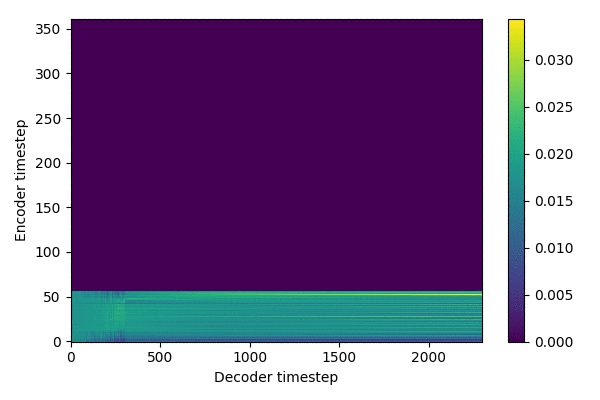tacotron2-vae
Overview
- Generate emotional voices by receiving text and emotional label as input
- Korean Version of "Learning Latent Representations for Style Control and Transfer in End-to-end Speech Synthesis"
Data
-
Dataset
- Korean Speech Emotion Dataset (more info)
- Single Female Voice Actor recorded six diffrent emotions(neutral, happy, sad, angry, disgust, fearful), each with 3,000 sentences.
- For training, I used four emotions(neutral,happy,sad,angry), total 21.25 hours
-
Text
- test:
python -m text.cleaners - examples
감정있는 한국어 목소리 생성 ==> ['ᄀ', 'ㅏ', 'ㅁ', 'ᄌ', 'ㅓ', 'ㅇ', 'ᄋ', 'ㅣ', 'ㅆ', 'ᄂ', 'ㅡ', 'ㄴ', ' ', 'ᄒ', 'ㅏ', 'ㄴ', 'ᄀ', 'ㅜ', 'ㄱ', 'ᄋ', 'ㅓ', ' ', 'ᄆ', 'ㅗ', 'ㄱ', 'ᄉ', 'ㅗ', 'ᄅ', 'ㅣ', ' ', 'ᄉ', 'ㅐ', 'ㅇ', 'ᄉ', 'ㅓ', 'ㅇ', '~'] ==> [2, 21, 57, 14, 25, 62, 13, 41, 61, 4, 39, 45, 79, 20, 21, 45, 2, 34, 42, 13, 25, 79, 8, 29, 42, 11, 29, 7, 41, 79, 11, 22, 62, 11, 25, 62, 1] - test:
-
Audio
- sampling rate: 16000
- filter length: 1024
- hop length: 256
- win length: 1024
- n_mel: 80
- mel_fmin: 0
- mel_fmax: 8000
-
Training files
./filelists/*.txt- path | text | speaker | emotion
- examples
/KoreanEmotionSpeech/wav/neu/neu_00002289.wav|선생님이 초록색으로 머리를 염색하고 나타나서 모두들 깜짝 놀랐다.|0|0 /KoreanEmotionSpeech/wav/sad/sad_00002266.wav|과외 선생님이 열심히 지도해준 덕택에 수학실력이 점점 늘고 있다.|0|1 /KoreanEmotionSpeech/wav/ang/ang_00000019.wav|명백한 것은 각 당이 투사하고 있는 실상과 허상이 있다면 이제 허상은 걷어들여야 한다는 것이다.|0|2 /KoreanEmotionSpeech/wav/hap/hap_00001920.wav|강력한 스크럽으로 상쾌한 양치효과를 주네요.|0|3
Training
- Prepare Datasets
- Clone this repo:
git clone https://github.com/jinhan/tacotron2-vae.git - CD into this repo:
cd tacotron2-vae - Initialize submodule:
git submodule init; git submodule update - Update .wav paths:
sed -i -- 's,DUMMY,ljs_dataset_folder/wavs,g' filelists/*.txt - Install requirements
pip install -r requirements.txt - Training:
python train.py --output_directory=outdir --log_directory=logdir -- hparams=training_files='filelists/koemo_spk_emo_all_train.txt',validation_files='filelists/koemo_spk_emo_all_valid.txt',anneal_function='constant',batch_size=6 - Monitoring:
tensorboard --logdir=outdir/logdir --host=127.0.0.1 - Training results (~ 250,000 steps)
Visualization
source: inference.ipynb
-
Load Models
tacotron2-vae model
model = load_model(hparams) model.load_state_dict(torch.load(checkpoint_path)['state_dict']) _ = model.eval()
WaveGlow vocoder model
waveglow = torch.load(waveglow_path)['model'] waveglow.cuda()
-
Load Data
- 'Prosody' is the output of the fully connected layer to match dimension of z and text-encoded output.
path = './filelists/koemo_spk_emo_all_test.txt' with open(path, encoding='utf-8') as f: filepaths_and_text = [line.strip().split("|") for line in f] model.eval() prosody_outputs = [] emotions = [] mus = [] zs = [] for audio_path, _, _, emotion in tqdm(filepaths_and_text): melspec = load_mel(audio_path) prosody, mu, _, z = model.vae_gst(melspec) prosody_outputs.append(prosody.squeeze(1).cpu().data) mus.append(mu.cpu().data) zs.append(z.cpu().data) emotions.append(int(emotion)) prosody_outputs = torch.cat(prosody_outputs, dim=0) emotions = np.array(emotions) mus = torch.cat(mus, dim=0) zs = torch.cat(zs, dim=0)
-
Scatter plot
colors = 'r','b','g','y' labels = 'neu','sad','ang','hap' data_x = mus.data.numpy() data_y = emotions plt.figure(figsize=(10,10)) for i, (c, label) in enumerate(zip(colors, labels)): plt.scatter(data_x[data_y==i,0], data_x[data_y==i,1], c=c, label=label, alpha=0.5) axes = plt.gca() plt.grid(True) plt.legend(loc='upper left')
-
t-SNE plot
colors = 'r','b','g','y' labels = 'neu','sad','ang','hap' data_x = mus data_y = emotions tsne_model = TSNE(n_components=2, random_state=0, init='random') tsne_all_data = tsne_model.fit_transform(data_x) tsne_all_y_data = data_y plt.figure(figsize=(10,10)) for i, (c, label) in enumerate(zip(colors, labels)): plt.scatter(tsne_all_data[tsne_all_y_data==i,0], tsne_all_data[tsne_all_y_data==i,1], c=c, label=label, alpha=0.5) plt.grid(True) plt.legend(loc='upper left')
Inference
source: inference.ipynb
Reference Audio
-
Generate voice that follows the style of the reference audio
Reference audio
def generate_audio_vae_by_ref(text, ref_audio): transcript_outputs = TextEncoder(text) print("reference audio") ipd.display(ipd.Audio(ref_audio, rate=hparams.sampling_rate)) ref_audio_mel = load_mel(ref_audio) latent_vector, _, _, _ = model.vae_gst(ref_audio_mel) latent_vector = latent_vector.unsqueeze(1).expand_as(transcript_outputs) encoder_outputs = transcript_outputs + latent_vector synth, mel_outputs = Decoder(encoder_outputs) ipd.display(ipd.Audio(synth[0].data.cpu().numpy(), rate=hparams.sampling_rate)) ipd.display(plot_data(mel_outputs.data.cpu().numpy()[0]))
Generate voice
text = "이 모델을 이용하면 같은 문장을 여러가지 스타일로 말할 수 있습니다." ref_wav = "/KoreanEmotionSpeech/wav/ang/ang_00000100.wav" generate_audio_vae_by_ref(text, ref_wav)
Interpolation
-
Create a new z by multiply ratios to the centroids.
Interpolation
def generate_audio_vae(text, ref_audio, trg_audio, ratios): transcript_outputs = TextEncoder(text) for ratio in ratios: latent_vector = ref_audio * ratio + trg_audio * (1.0-ratio) latent_vector = torch.FloatTensor(latent_vector).cuda() latent_vector = model.vae_gst.fc3(latent_vector) encoder_outputs = transcript_outputs + latent_vector synth, mel_outputs_postnet = Decoder(encoder_outputs) ipd.display(ipd.Audio(synth[0].data.cpu().numpy(), rate=hparams.sampling_rate)) ipd.display(plot_data(mel_outputs_postnet.data.cpu().numpy()[0]))
Get Centroids
encoded = zs.data.numpy() neu = np.mean(encoded[emotions==0,:], axis=0) sad = np.mean(encoded[emotions==1,:], axis=0) ang = np.mean(encoded[emotions==2,:], axis=0) hap = np.mean(encoded[emotions==3,:], axis=0)
Generate voice
text = "이 모델을 이용하면 같은 문장을 여러가지 스타일로 말할 수 있습니다." ref_audio = hap trg_audio = sad ratios = [1.0, 0.64, 0.34, 0.0] generate_audio_vae(text, ref_audio, trg_audio, ratios)

Mixer
-
Result of mixing more than two labels at a desired ratio
Mixer
def generate_audio_vae_mix(text, ratios): transcript_outputs = TextEncoder(text) latent_vector = ratios[0]*neu + ratios[1]*hap + ratios[2]*sad + ratios[3]*ang latent_vector = torch.FloatTensor(latent_vector).cuda() latent_vector = model.vae_gst.fc3(latent_vector) encoder_outputs = transcript_outputs + latent_vector synth, mel_outputs = Decoder(encoder_outputs) ipd.display(ipd.Audio(synth[0].data.cpu().numpy(), rate=hparams.sampling_rate)) ipd.display(plot_data(mel_outputs.data.cpu().numpy()[0]))
Generate voice
text = "이 모델을 이용하면 같은 문장을 여러가지 스타일로 말할 수 있습니다." ratios = [0.0, 0.25, 0.0, 0.75] #neu, hap, sad, ang generate_audio_vae_mix(text, ratios)
Demo page
- Run:
python app.py --checkpoint_path="./models/032902_vae_250000" --waveglow_path="./models/waveglow_130000" - Mix: Generate voices by adjusting the ratio of netural, sad, happy, and angry
- Ref Audio: Generate voices by testset audio as a reference audio
Samples
- Interpolation: Result of interpolating between two labels at 1.0, 0.66, 0.33, and 0.0
- refs: Result of recorded audio as a reference audio
- mix: Result of mixing more than two labels at a desired ratio
References
- Tacotron2: https://github.com/NVIDIA/tacotron2
- Prosody Encoder: https://github.com/KinglittleQ/GST-Tacotron/blob/master/GST.py
- WaveGlow: https://github.com/NVIDIA/waveglow
- Export Images from tfevents: https://github.com/anderskm/exportTensorFlowLog




